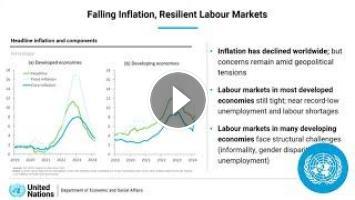Global economic prospects have improved since January, with major economies avoiding a severe downturn, bringing down inflation without increasing unemployment, according to the World Economic Situation and Prospects mid-2024 update released today (16 May).
------------------------
At the launch of the report, the Director of Economic Analysis and Policy Division at the Department of Economic and Social Affairs (DESA), Shantanu Mukherjee, said, “our prognosis is one of guarded optimism, but with important caveats.”
Mukherjee explained that for 2024, “global growth forecast is now estimated to be 2.7 percent, which is up from the 2.4 percent we were expecting in January, and for 2025 we are expecting 2.8 percent, also up a little bit from what we were thinking earlier,” and noted these changes “are actually coming from better-than-expected performance in some of the large developed and emerging economies.”
On the other hand, he said, “the outlook for many developing countries is not as rosy,” and prospects for growth in 2024 and 2025 remain “much below the pre pandemic average.”
Importantly, Mukherjee added for Africa and Least Developed Countries (LDCs), “prospects are revised downward to about 3.3 percent growth in 2024.”
The DESA official told journalists in New York that the new report includes a supplement on minerals.
He said, “we are exploring, two intertwined issues which we think are important. The first is how to encourage the production and availability of critical minerals, at the scale and speed that is needed for the energy transition. And the second is, how can those countries that are rich in these resources, leverage these to turn into long term SDG gains? The second question we think, ties into the HLPF session this year in particular, but it's also particularly important because when growth overall is kind of low, this is an area where there is potential to deliver greater gains.”
DESA’s Chief of the Global Economic Monitoring Branch in the Economic Analysis and Policy Division, Hamid Rashid, explained that lithium production “is concentrated in two countries, Australia and Chile,” while processing “is mostly concentrated in China.”
The report underscored that countries endowed with critical mineral resources will need smart policies, as well as effective implementation capacities to reap the benefits and avoid a renewed ‘resource curse.’ Moreover, international cooperation will remain crucial to facilitate technology transfers and financing to developing countries, combat illicit financial flows and ensure the supply of the critical minerals needed for the green transition.
Mid-year update of the World Economic Situation and Prospects 2024: https://www.un.org/development/desa/dpad/publication/world-economic-situation-and-prospects-as-of-mid-2024/
------------------------
At the launch of the report, the Director of Economic Analysis and Policy Division at the Department of Economic and Social Affairs (DESA), Shantanu Mukherjee, said, “our prognosis is one of guarded optimism, but with important caveats.”
Mukherjee explained that for 2024, “global growth forecast is now estimated to be 2.7 percent, which is up from the 2.4 percent we were expecting in January, and for 2025 we are expecting 2.8 percent, also up a little bit from what we were thinking earlier,” and noted these changes “are actually coming from better-than-expected performance in some of the large developed and emerging economies.”
On the other hand, he said, “the outlook for many developing countries is not as rosy,” and prospects for growth in 2024 and 2025 remain “much below the pre pandemic average.”
Importantly, Mukherjee added for Africa and Least Developed Countries (LDCs), “prospects are revised downward to about 3.3 percent growth in 2024.”
The DESA official told journalists in New York that the new report includes a supplement on minerals.
He said, “we are exploring, two intertwined issues which we think are important. The first is how to encourage the production and availability of critical minerals, at the scale and speed that is needed for the energy transition. And the second is, how can those countries that are rich in these resources, leverage these to turn into long term SDG gains? The second question we think, ties into the HLPF session this year in particular, but it's also particularly important because when growth overall is kind of low, this is an area where there is potential to deliver greater gains.”
DESA’s Chief of the Global Economic Monitoring Branch in the Economic Analysis and Policy Division, Hamid Rashid, explained that lithium production “is concentrated in two countries, Australia and Chile,” while processing “is mostly concentrated in China.”
The report underscored that countries endowed with critical mineral resources will need smart policies, as well as effective implementation capacities to reap the benefits and avoid a renewed ‘resource curse.’ Moreover, international cooperation will remain crucial to facilitate technology transfers and financing to developing countries, combat illicit financial flows and ensure the supply of the critical minerals needed for the green transition.
Mid-year update of the World Economic Situation and Prospects 2024: https://www.un.org/development/desa/dpad/publication/world-economic-situation-and-prospects-as-of-mid-2024/
- Category
- United Nations
- Tags
- UN, United Nations, UNGA
Be the first to comment













